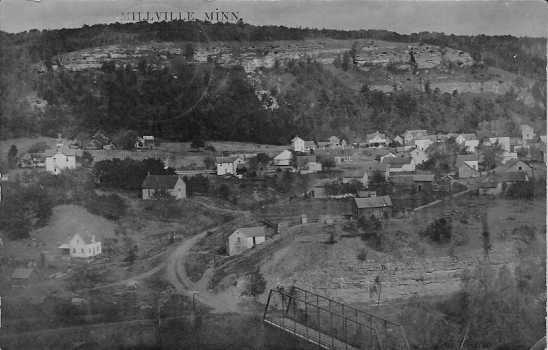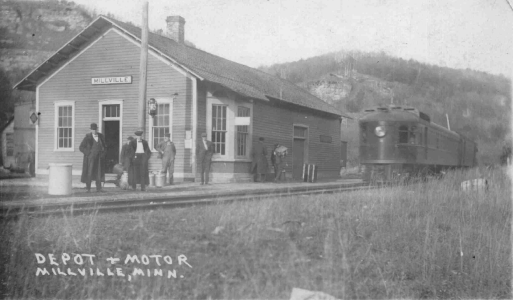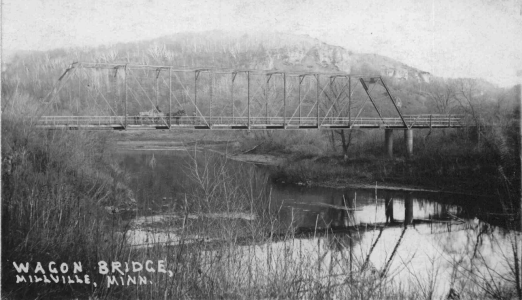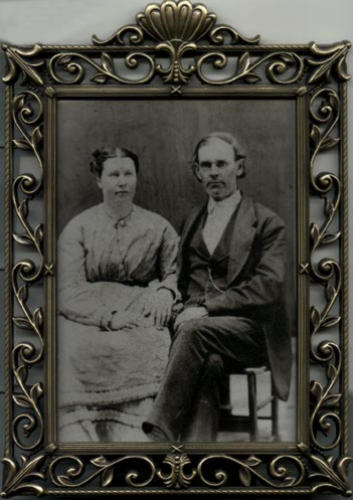


 |
 |
 |
|
|
Navigation LakesnWoods.com
© 2004-2025 DCMA, Defamation, Copyright and Trademark Infingement Policy
|
|
 Millville in 1908 Contributed by Chris Miller Millville is a village on the Chicago, Milwaukee & St. Paul Railway, 29 miles southwest of Wabasha. It is in Section 18, Oakwood Township and is picturesquely situated on heights overlooking the Zumbro Valley, the station itself lying in the valley. Though it is a small place, it is essentially an up-to-date community, having constructed water-works, established a commercial club, known as the Millville Improvement Club, and having a weekly newspaper ~ The Millville Review, a hotel, a grain elevator, the Millville State Bank, and the Millville creamery, besides several stores and other places of business. The Greenwood Prairie Telephone Company furnishes local communication with the surrounding country, and there are two churches, Evangelical and Swedish Lutheran.  Millville Depot & Motor (Does 'Motor' Mean 'Engine'?) Contributed by Sue Buck Millville was started in 1870, when John Huny opened a store. The post-office was moved to the store from a nearby farm, and Mr. Huney (sic) made postmaster. Peter Holtein built a blacksmith shop the same year. The coming of the railroad gave the village new life, and soon there was (sic) two stores, owned by J. B. Miller and Mullen & Leonard; next two hotels; then John Behrns ran a store for a time; then were built a wagon-shop; a small grainhouse, in which was the warehouse and telegraph office; next year the depot and addition to the grainhouse; then a fancy-store and a shoeshop. In 1880 McGuigan Bros., drygoods and goceries, and J. S. Bisby, hardware, started business, and in 1881 Claus Beherns run (sic) the Midland brewery, but it was accidentally burned.  Wagon Bridge at Millville Contributed by Sue Buck Millville Post Office was established in 1869, on the farm of Ole Christopher, with Charles Flemming as postmaster. It was moved to the village in 1870 and John Huny made postmaster. The Millville State Bank was organized September 27, 1904, with a cash capital of $20,000, and with J. W. Nolan as president, W. H. Kiley, vice-president, and P. J. Cosgrove, cashier. The bank has proved a strong factor in the upbuilding of the community. At the end of the year 1919 its statement showed a surplus of $8,000 and deposits of $274,000, its capital remaining at $10,000. The present officers are: J. W. Nolan, president; W. H. Kiley, vice-president; P. J. Cosgrove, cashier; W. H. Wadley, assistant cashier; Albert Olson and P. J. Polson. (Webmaster's note: I have copied this last sentence exactly as it appear in the book.) Oakwood Township embraces Township 109, Range 12. It is bounded on the north by West Albany, on the east by Highland, on the south by Elgin and a small part of Plainview and on the west by Hyde park and Zumbro. A rolling prairie, bordering on Greenwood Prairie, it is cut by the rocky Zumbro valley, separating the several northwestern sections from the main part; by the Middle Creek ravine separating the several northeastern sections; and lastly, by the Long Creek ravine, which winds through the center from south to north, and opens into the Zumbro valley not far from the opening of Middle creek. Along their route smaller valleys and ravines open into these. The Zumbro valley, with its rocky cliffs varying from two hundred to three hundred and seventy feet in height, overhanging and winding its rocky and wooded sides about in a bewildering manner, affords some very picturesque and romantic scenery. While the northern part of the township is chiefly clay, the southern is more black loam and clay mixed, making a fine soil. The oak, hazel, etc., underbrush that once nearly covered the prairie, is now confined to the bluffs, valleys and ravines. In the northern part of the township, in the coolies, there is more timber-oak, elm, cottonwood and maple. Along the Zumbro River valley are river-terraces about half-way up the bluffs, some of the larger of which are of sufficient size for a village. Lyman Gregg prospected for claims here in 1855 but did not settle here. Henry Powell took a claim in 1855. The settlers of 1856 were: Mathew Kinsella and his son Mathew, David and James Foley, Patrick and Lawrence Tracey and William Tope. About this time also came Bernard McNulty, James McPike, Michael Campbell, Patrick McQuigan, Henry Martin and Patrick Fleming. Many of these came prospecting, selected homes and built huts, then in the fall returned to their former homes to get their families. Mr. Crozier was also here, living in his wagon. The bachelor life led by many of these in their wagon or hut was not enviable. Patrick McQuigan brought for his winter supply seven barrels of flour; the Indians were difficult to convince that his house was not an agency. One of the heaviest snows fell that winter, about four feet on a level. The Indians, with snow-shoes, killed deer extravagantly; finding them in the valley in an open place corralled by the deep snow, they would kill them merely for the skin. About seven hundred were camping in the valley that winter. They were not troublesome, and not many months later left. Mat. Kinsellas, St. and Fr., Charles and Patrick Fleming, Richard Leighart and James Perkins kept bachelor's hall for nearly three years. They had five yoke of oxen, and all worked together, each helping the other. The first roads were across the prairie toward Plainview, the nearest way. The first bluff-road was between Millville site and P. G. Dickman's. The first surveyed road was laid out about 1859, along the south side of section 25, and south and west sides of section 26, north, entering the long creek ravine. It was known as the long Creek road. The second laid out was probably that from Bremen, passing Messrs. Quisel's, Grove's and Pratt's, about 1860. On account of ravines few of the roads follow section lines. James Chapman, on northeast part of section 22, built the first sawmill of the township, about 1860, but soon sold it to Abner Tibbets, who continued it for but a few years. The first gristmill was built on Middle creek in 1868 by Samuel Irish. The first blacksmith-shop was built by Henry Powell, probably in 1856; the only one until Peter Holstein built his in Millville a number of years later. The first birth was Patrick Tracy's daughter, Elizabeth Tracy, in February, 1857. Anna Tracy, daughter of Lawrence Tracy, was born in March following. The first marriage ceremony was performed by Father Tissot, a Catholic missionary, when he gave Mathew Kinsella, Jr., a wife. Henry Powell was married quite early, too, and in a romantic manner. It is said he and his intended stood on one bank of Long creek, while the justice stood on the opposite shore and performed the ceremony. Death made his first visit in the spring of 1858, taking a babe of William Tope, and one of George Martin. The first (private) school was taught either by Mrs. Louis Evans or Mrs. J. H. Bernard, at their homes, in the winter of 1859-60. Mr. Evans also taught early school. The first schoolhouse was in district No. 24, near Patrick McQuigan's, built about 1861. Dr. James Chapman, the builder of the first sawmill, was the first physician, starting in the winter of 1858 and after. He also preached, holding services now and then at his home and at the Powell's.  James H. and Sarah E. Chapman Photo contributed by Florence Allen The town was organized May 11, 1858, the first town meeting being held on that date. Originally it was called Pell or Pellville in honor of John H. Pell. The first chairman was Lawrence Tracy and the first clerk was Dr. James Chapman. The first records are destroyed. Prominent in the early official history of the town were James Foley, John Behrns, J. K. Smith, Claus Behrns, and J. Evans. From Pell the name of the town was changed to Sherman and in 1872 to Oakwood. In the winter of 1858-59, the several northwestern sections of the township cut off by the Zumbro were joined to West Albany, but in 1867, the legislature at the request of the people returned the sections to their former jurisdictions, thus giving the town its present boundaries. When the Midland Railroad Co. was projected the town voted bonds of $22,000. The first town hall was built in 1875 on section 15, but was several years afterward sold, and a schoolhouse secured for town meetings. The Oakwood Catholic Church dates back to the early days. In 1858 Father Tissot first held mass in David Foley's house. From then until 1867 it was held about five times a year at Mathew Kinsella's. During 1866 the church was also started. Early priests were the Rev. Fathers Tissot, Trobec, Jeram, Reinhardt and Murray. Keegan is a railroad station in section 3. It was named from the owner of the land, J. Keegan, [and] was started in 1879 as a station. A saloon, blacksmith-shop and store, the last mentioned kept by J. Judge, comprised its business until 1880, when the depot and grain-house was added. The following year Mr. Judge was made postmaster of the new postoffice. A bridge crosses the Zumbro here, which, with the Millville bridge, includes all Zumbro bridges in the township. Highland Township embraces Congressional Township 109, Range 11. It is bounded on the north by Glasgow, on the east by Watopa, on the south by Winona County and Plainview Township, and on the west by Oakwood. The soil is a black loam with a clay subsoil, heavier in the northern and central portions, and lighter on the more open prairie-like portions in the south. The surface is undulating, and in the north and east broken by bluffs and high hills that hedge in more or less narrow valleys. Along these bluff ledges grow stubby oaks and other woods, and more or less undergrowth. Through these valleys flow such streams as pay tribute to the Zumbro on the north. The largest of these is known as West Indian creek; it rises in the southern central part of the township and flows down a beautiful valley, from twenty to one hundred rods in width, to the northward. Early in 1855, Oliver Nelson and his family settled near the southern line of what is now Highland Township. Their activities were largely confined, however, to the northern part of Plainview Township. Patrick McDonough came that year and settled in the northeast corner in Cook's Valley. John Canfield came at about the same time. The first birth of a white child in the township occurred some time in the spring or summer of 1855, the child being Maria Sullivan, daughter of Thomas and Mary Sullivan. The first deaths of settlers also occurred during this season, the victims being two men by the names of Pugh and Green, who had come on to build them homes in the western Eldorado. They had scarcely more than had time to rear a humble habitation when they were stricken down with cholera morbus and lived but a few hours. Fear of the disease seized the few neighbors that surrounded them, and they were buried by a few faithful friends at night in Cook's valley, near their deserted domicile, without funeral rites. It was not until the opening of another season that the tide of immigration seemed to set in toward Highland; but in 1856 and 1857 there flocked in from the states a large number of Irish and Germans, and a fair sprinkling of Yankees. In 1856 Daniel J. Watkins erected a sawmill on West Indian creek, on section 16, in Highland. Five years later Mr. Watkins found that the community had greater need for a gristmill than they had for a sawmill, and at once proceeded to remove the latter and erect in its stead the first gristmill of Highland. This same season Alfred Lathrop opened a store nearby, and the following Year, 1862, Lyons post-office was established here, with Mr. Lathrop as postmaster. The post-office was discontinued in 1881. In 1866 Henry Hampe erected a gristmill on Indian creek, about two miles below the Watkins mill. This mill was burned down February 19, 1881. In 1858 the inhabitants of Highland petitioned the postal authorities for the establishment of a post-office in southeast Highland, along the Rochester and Wabasha stage route. The petition was granted, a commission was issued to Israel Smith as postmaster, and the office was dubbed Smithfield; before the arrival of this commission Mr. Smith left the country. Soon after Thomas Smith opened a little store on section 24, and was about to be appointed to this office when his store burned down, and he also departed from the country. The third petition in the summer of 1859 resulted in James S. Felton becoming the first postmaster. This same summer the Dugans, of Wabasha, who had quite an extensive landed interest in this part of the country, erected a store and a hotel; a blacksmith-shop was also a feature of this pioneer hamlet. In 1862 the Jameses bought out the Dugans, and about three years later abandoned the store and closed up the hotel, thus terminating the business life of Smithfield, though the post-office was continued for many years. C. G. Dawley was the postmaster for a long period. The first teaching was done by Ursula Metcalf, afterward wife of Levi Emery, in district 39, known as the Rich district, in the southwestern portion of the township. In district 37, or the Stanfield Spring school, the first teaching was in a log house near the site of the present building, in the spring of 1860, by Aurora Albertson. In the Highland district, No. 40, Ann Robbins taught a school in the summer of 1859. The schoolhouse was an octagonal structure, provided by Wm. T. James, then a prominent man in that part of the township. It was framed in Wabasha and drawn to the place of erection in sections, and for years did duty as both church and schoolhouse. The Hampe Mill district, No. 64, and the Appel's Mill district, no. 66, both located in West Indian Creek valley, were also pioneer districts. The schoolhouses in Highland are in excellent condition, and are in marked contrast with the rude log huts that only a few years ago attested the high regard which the poor but intelligent pioneers of this township had for education in early days. The first Protestant preaching in the Highland district was done by the Rev. J. L. Dyer in the fall of 1859, at the residence of Stillman Hathaway; and the following year the Methodist and Baptist societies were organized. A Sunday school was also established about this time, with A. T. James as the first superintendent. Of religious life in Highland in 1884 it has been said: "The remnants of the once thriving Baptist, Methodist, Congregationalist and Lutheran societies are scattered, and have been gathered into other Christian folds, principally located in the neighboring village of Plainview. Preaching is occasionally held in the Highland schoolhouse, in southeast Highland, and the Methodist Episcopal society (chiefly Norwegians) have a parsonage and sustain regular services in the southwest part of the township; while at Hampe's Mill there still stands the old log church erected by the German Reform of Evangelical congregation in 1866, and still supplied with a pastor, who resides in West Albany, but holds services here biweekly. The Presbyterians in an early day were also sufficiently strong to sustain preaching at the Appel Mills schoolhouse, but have not been able to keep up their organization of late years. Each society of three ~ Baptist, Methodist and Congregationalist ~ has taken its turn at conducting revivals in the Highland schoolhouse, and much vigorous religious work has been done within its walls." Church of the Immaculate Conception. Religious services were held in this parish at an early date in private houses, and so continued until 1866, when the first church, a frame structure, 12 by 20 feet, was built by Father Tissot, who had charge of the Catholics in this vicinity. This little church was enlarged by Father James Trobec, pastor at Wabasha, who then had charge of Conception. The first parsonage was built about 1881, in which year the first resident pastor, Rev. peter Jeram, took charge of the parish. He served until the following year and was succeeded by Rev. Benedict Beinhart, who remained until the spring of 1883. The next pastor, Rev. P. B. Murray, served from 1883 to the fall of 1887, and was succeeded by Rev. E. Stack, who remained in charge from 1887 to the spring of 1899. After him came Rev. Father Hartlieb, 1899 to 1900, and then Rev. A. Aufenholk, 1900 to 1901. Rev. W. E. F. Griffin was the pastor from 1901 to 1904. Father Griffin built the present church, a large brick structure, in 1903. Rev. Father Hartlieb was pastor from 1904 to 1905, being succeeded in the fall of the latter year by Rev. J. C. Pudenz, who served until 1911. Rev. Joseph Zahner served from 1911 until his death in February, 1919. It was he who built the new house in 1918. After Father Zahner's death the parish was supplied from St. Mary's College until the winter of 1920, when the present pastor, Rev. B. A. Kramer, was appointed. The cemetery, donated by Mr. T. Ryan, is called St. Peter and Paul's. Since 1903 the pastors at Conception have also served St. Joseph's parish at Theilman. The first town meeting in Highland was held May 13, 1858, at the residence of I. Smith, in the southeast portion of the township, near where the Smithfield post-office was that year located. W. L. Cleaveland presided over the meeting and was elected chairman of the board of supervisors, of which C. G. Dawley and R.M. Doane were also chosen members. The other officers elected at this meeting were as follows: J. R. Cleaveland, clerk; M. Baldwin, overseer of poor; Volney Crandall, assessor; James Felton and A. C. Smith, justices of the peace; George Begg and Oliver Nelson, constables; and George Begg, collector. The township expenses for that year were, all told, fifty dollars. In 1858 the first road in the township was laid out and worked; the same being the road that connects Appel's (then Watkins') Mill with Canfield Springs. It is now well provided with suitable highways leading out in all directions; many of them following the course of ravines. |
This history originally located at
http://www.rootsweb.ancestry.com/~mnwabbio/3ch16.htm
Original page was difficult to read due to fixed width background used
|
|
|
|
|||||
|
|
© 2004-2025 LakesnWoods LLC All Rights Reserved |
|
|||
|
| |||||